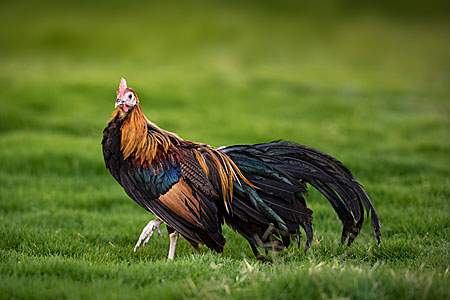
Longtail chickens require specialized treatment to maintain the beauty of their lavish tail feathers. Here are 7 ways the care and feeding of longtail roosters differs from that of other chicken breeds.
1. Plenty of Perches
A lot of what we know about caring for longtail chickens comes from the traditional management of Onagadori roosters in Japan. Onagadoris are often confined to perches to prevent wear to their tail feathers, which may grow 6½ feet or longer. Perches are positioned high enough to prevent the tail feathers from hanging down into the litter, where they might get soiled. Perches are also spaced far enough apart, and not crossed, to prevent tail feathers from getting tangled in them. Like the Onagadori, longtail chickens of North America fly well and can easily reach high perches.
2. Spacious Coop
Along with plenty of high perches, longtails need spacious housing to minimize wear on their tail feathers. According to Megumi Aviary, Onagadoris may be individually kept in 6-foot by 6-foot by 8-foot stalls with thick bedding, and walked in a yard daily. North American longtails don’t need as much space because their tail feathers don’t grow as long. But their tail feathers are longer than those of most other chicken breeds, so they do need plenty of coop space — on the order of at least 4 square feet per bird.
3. Large Yard
Longtails are active birds that enjoy the freedom offered by a large yard. Outdoor pens are typically tall, covered to prevent flying out and to provide protection from weather, and fitted with wind breaks of one sort or another to keep out strong winds. A spacious yard should provide at least 10 square feet per bird. Alternatively, longtails enjoy free ranging.
4. Clean Environment
Deep shavings inside the coop, removed and replaced at least weekly, help keep filth from clinging to the tail feathers. Onagadori tails are often tied in loops with strips of silk fabric to keep the feathers clean and prevent fraying. Except for show birds, most North American longtail keepers don’t bother tying the tails.
5. High Protein Diet
Exceptional tail growth requires a high-protein diet. A game bird ration containing 20% protein is ideal.
Some longtail keepers feed regular chicken rations with high-protein supplements such as meat scraps or legumes. But too much protein can eventually lead to permanent kidney damage, so don’t overdo it.
6. Balmy Weather
Longtails do better in a warm climate than in a cold climate. They are healthiest at temperatures of 50ºF and above, and away from buffeting winds and drafts.
7. Discourage Molting
North American longtails lack some of the genetic factors that control the tail growth of Onagadoris, including full express of the nonmolting gene. Therefore, most of them molt their tail feathers and grow new ones annually. Among longtail breeds of North America, Phoenix and Yokohama roosters grow the longest tail feathers.
With a little luck, you might end up with a Phoenix rooster that molts only every other year, and therefore develops a longer tail than one that molts annually. In any case, you want to avoid conditions that might trigger a premature molt. One is water deprivation, which may occur in summer when birds drink more than usual and run out, or in winter when water freezes. Another is fewer than 15 daylight hours per day, which can be remedied using electric lights to augment natural light during the short-day season.
Megumi Aviary additionally suggests keeping the hens where the roosters can’t see them, as the sight of hens would prompt a hormone-induced molt. They also suggest a daily feeding of raw green cabbage, which they describe as a goitrogen that slows the production of hormones that induce molt.
For in-depth information on longtail chickens, check out the book Long Tail Fowl, Their History and Care by David Rogers and Toni-Marie Astin. You might also visit them on Facebook or follow David Rogers’ Onagadori blog for more tips on the care and feeding of longtail roosters.
And that’s today’s news from the Cackle Coop.
Gail Damerow is the author of Storey’s Guide to Raising Chickens.
Photo by Yasser Al-Mulqi.

